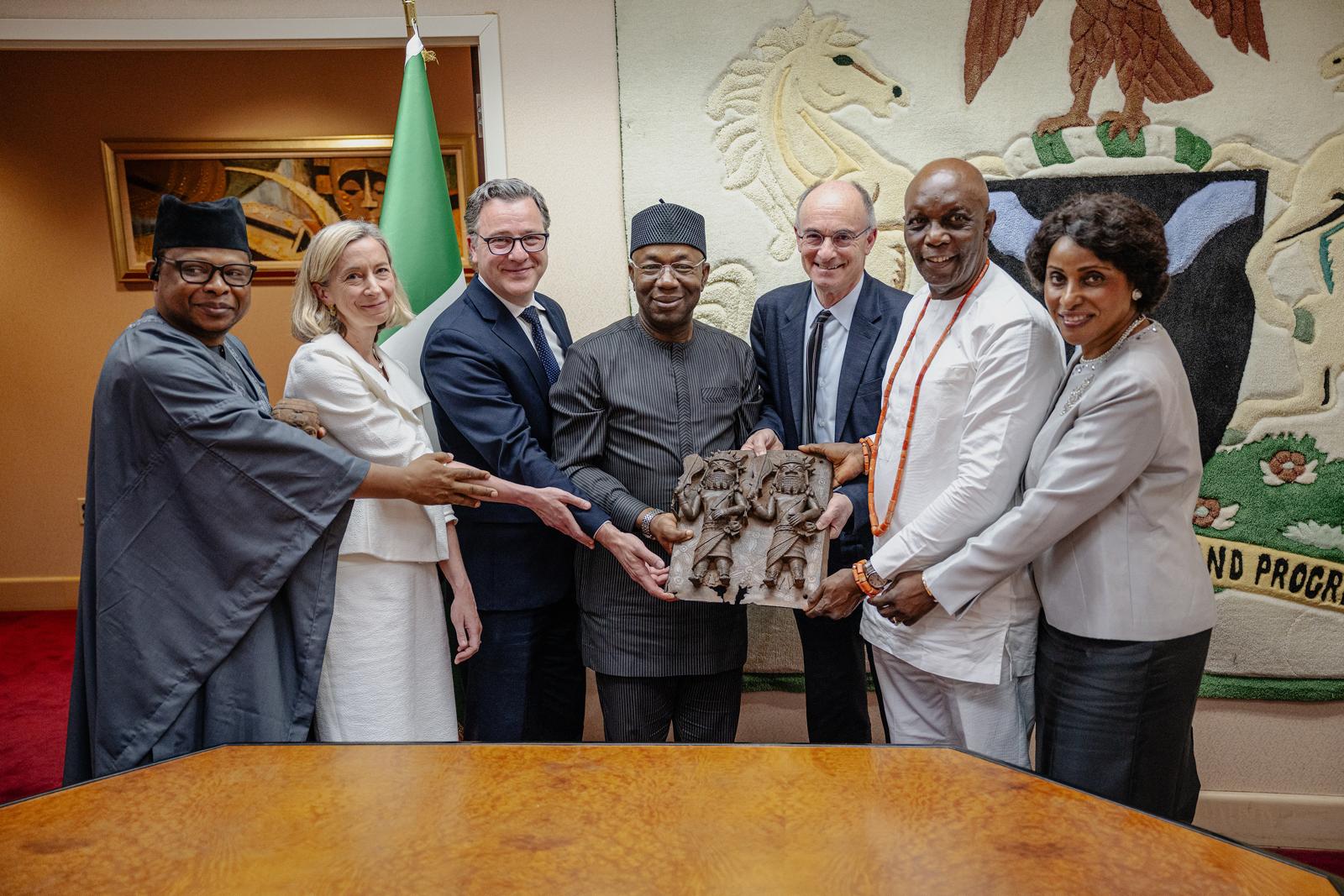In a significant milestone for cultural restitution and historical justice, the Museum of Fine Arts, (MFA) Boston, formally returned two looted artifacts from the historic Benin Kingdom to His Royal Majesty, Omo N’Oba Ewuare II, the Oba of Benin. The official handover took place at the Nigeria House in New York City, the diplomatic mission housing Nigeria’s Permanent Mission to the United Nations and the Consulate General. The returned artifacts; a terracotta and iron Commemorative Head (16th – 17th century) and a bronze Relief Plaque Showing Two Officials with Raised Swords (16th century), were looted during the violent British raid on Benin in 1897 and have been part of the MFA’s collection since the 2010s.
The long overdue return ceremony was attended by dignitaries including His Royal Highness Prince Aghatise Erediauwa, representing the Oba of Benin; HE Ambassador Samson Itegboje of the Embassy of Nigeria; HE Ambassador Abubakar Jidda, Consul General of Nigeria in New York; and Matthew Teitelbaum, Director of the MFA. Members of the Benin community in New York and other cultural officials were also present. “For more than a century, these pieces were housed far from their origins, the Benin Royal Court,” said Teitelbaum. “To be able to return them now, with dignity and partnership, is both a moral imperative and a deeply rewarding act for us as a museum.”
The transfer was coordinated by Dr. Arese Carrington, a member of the MFA’s Board of Advisors and a longtime advocate for African cultural repatriation. The National Commission for Museums and Monuments of Nigeria, working alongside the Nigerian Embassy in Washington, D.C., will oversee the artifacts’ safe transit to Benin City, where they will be formally received by the Oba and re-integrated into the royal collection.
The two artifacts were looted in 1897 during a punitive expedition by British colonial forces, which razed Benin City, exiled the then-Oba, and carted away thousands of cultural treasures. These artifacts, considered masterpieces of West African court art, were quickly sold in London, making their way through various private collections over the decades. The Commemorative Head appeared on the London art market in 1899, sold by dealer William Cutter to fellow dealer William Downing Webster. The Relief Plaque was traced directly to the Crown Agent of the Niger Coast Protectorate, who sold it in 1898 – barely a year after the Benin raid. Both were purchased by British collector Augustus Pitt-Rivers for his private museum, which closed in the 1960s. The items eventually passed to American financier and collector Robert Owen Lehman, who donated them to the MFA in 2013 and 2018 respectively.
While these two works have now been returned, the MFA acknowledged that three other Benin artifacts remain in its collection. The museum says their provenance remains “inconclusive” and that research continues to determine whether they too were taken illicitly. “We are committed to doing the work – researching, collaborating, and making transparent decisions based on ethics and evidence,” said Victoria Reed, the MFA’s Senior Curator for Provenance.
The return of the Benin artifacts is part of a broader push by the Nigerian government and the Royal Court of Benin to retrieve thousands of looted items scattered in museums across Europe and North America. In recent years, institutions like the Smithsonian, Germany’s Humboldt Forum, and the University of Aberdeen have returned significant pieces from their Benin collections. The Nigerian government has also opened dialogues with the British Museum, which still holds over 900 Benin Bronzes – the largest single collection globally.
“This return is not just symbolic; it is the restoration of dignity, identity, and sovereignty,” said Ambassador Itegboje. “These objects were never mere decorations. They are living pieces of our history and spirituality.”
Toward a New Era of Museum Ethics
The restitution ceremony adds momentum to a growing international movement calling for museums to repatriate artifacts acquired under colonial coercion, military conquest, or dubious legality.
“We are witnessing a transformation in how institutions reckon with their past,” said Dr. Carrington. “It is about rebalancing power and restoring truth. This return is a model of what cultural diplomacy should look like.”
As the Benin treasures journey home to Nigeria, they do so not only as works of art—but as emblems of resilience, cultural pride, and long-overdue justice.





